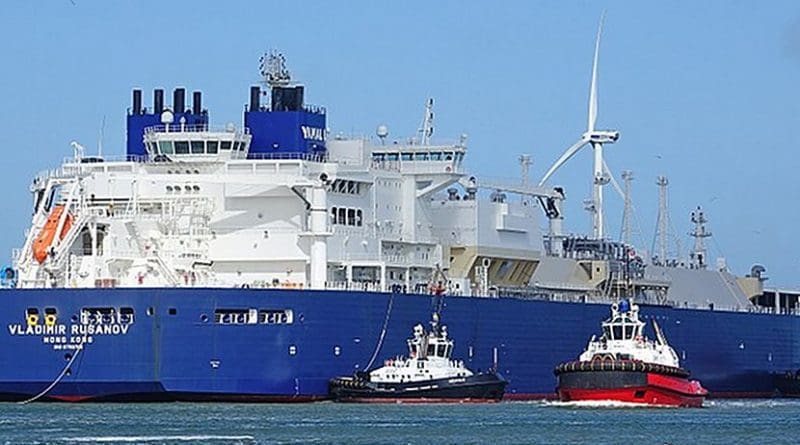China’s Evolving Arctic Policy: Two Geopolitical Threats – OpEd
By Qiyang Niu
On July 19, Russian natural gas company Novatek delivered the first ever liquefied natural gas (LNG) cargo to China via the Northern Sea Route in the Arctic. The route from Russia’s Sabetta port through the Bering Strait cuts delivery time to China’s east coast by over 20 days compared with the traditional Suez Canal-Strait of Malacca route. The shipment demonstrates China’s growing utilization of the Arctic.
Unlike its science-focused activities in the Arctic in the 1990s and early 2000s, since China started to push forward its observer status to the Arctic Council in 2008, China has increased its efforts in the economic field. After becoming an official observer to the Council in 2013, China has continued this shift of focus, introducing the concept of Polar Silk Road in 2017, and issuing its first Arctic Policy in 2018.
In the Arctic Policy, shipping routes are listed as a major field of engagement. Other fields of engagement include scientific research, climate change, Arctic resources (with the most emphasis), and international governance. All of these engagements, however, require investment from China. Therefore, though not stressed in the text, investment is the hidden key element of China’s Arctic Policy.
Looking at these fields of engagement, it is noticeable that they are perfectly in line with China’s foreign policy initiatives, including the Belt and Road Initiative, BRICS, Asian Infrastructure Investment Bank, “16+1” China-Central Eastern Europe Cooperation, and Shanghai Cooperation Organization, which also tend to focus on shipping routes, resources, investment, and multilateral governance. If these initiatives and institutes, as many observers argue, are indeed China’s tools of reshaping the current world order, then the Polar Silk Road, or China’s Arctic Policy, is likely a part of the toolset.
Against this backdrop, geopolitically, China’s efforts in the Arctic could represent two major threats to Arctic countries.
First, China’s increasing economic engagement with the region could threaten the political stability of Arctic countries. In mid-July, the new minister for foreign affairs of Greenland, an autonomous region of Denmark with an inclination toward independence, announced Greenland’s plan to open a representative office in Beijing to boost trade ties with China. Together with China’s potential investment in three airports on Greenland and expected participation in the territory’s largest mining projects, the plan raises worries from Denmark that Greenland’s increasing economic dependence on China will give China increased political influence in Arctic Council affairs. This concern is not groundless. China is skilled at and has a proven record of converting its financial investment to certain countries into political influence on multilateral institutions. In Europe, for instance, China’s close partnership with Greece and Hungary has succeeded in weakening the EU statement for the 2016 South China Sea arbitration result to the extent that it did not directly mention China. A similar influence has been exerted over Laos and Cambodia to give China a strong voice within ASEAN.
Second, the increasing presence of China in strategic locations of the Arctic could threaten the NATO-Russia balance in the region. The Russian navy has three fleets in Europe: the Baltic Fleet, the Black Sea Fleet, and the Northern Fleet. The former two’s access to the Atlantic Ocean can be easily blocked by NATO forces in the region. However, based in Murmansk, Russia’s aircraft-equipped Northern Fleet can break into the Atlantic via the GIUK gap—the choke point between Greenland, Iceland, and the U.K. Last year, Foreign Policy reported that new Russian submarines have been making frequent trips through the gap, and in July this year Chatham House also noted that the gap is often overlooked in NATO planning.
In recent years, however, China has been trying to purchase several pieces of land around the GIUK gap. In 2016, Chinese mining company General Nice Group attempted to buy an abandoned naval base in Greenland. In 2014, Huang Nubo, the 90th richest entrepreneur in China who has previously worked for the Communist Party, tried to buy a rare piece of land on Svalbard. Although he failed, he later successfully purchased a parcel of land in Lyngen, Norway, also in the Arctic circle. In 2011, Huang tried to buy 0.3% of Iceland’s total land.
With China’s ever-growing geopolitical ambitions, purchasing capacity, and political-economic influence, it is possible that Beijing will establish a stronger presence in the region. By marking the accomplished and attempted purchases on the map, it seems that China, if it aligns itself with Russia, would impose a critical impact to the region’s military balance by assisting Russia in and around the GIUK gap. Even if such a military alliance is not to be shaped given Russia’s vigilance of Chinese influence, China alone, given some time, could drastically change the balance in the region. Currently, China is growing its icebreaker fleet by building the Snow Dragon 2 and bidding for a nuclear-powered icebreaker. This would allow China to become the second country to own a nuclear icebreaker. Some observers believe that the nuclear vessel will pave the way for China to build a nuclear-powered aircraft carrier in the near future, which would not only be a game changer in the Asia-Pacific but also in the Arctic when the summer ice melts by the 2030s or the 2050s.
The opinions, beliefs, and viewpoints expressed by the authors are theirs alone and don’t reflect the official position of Geopoliticalmonitor.com or any other institution.

